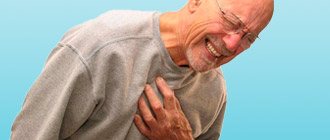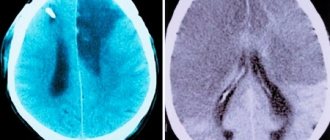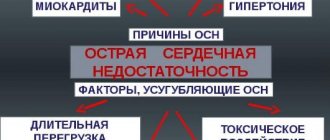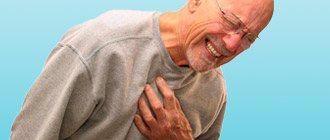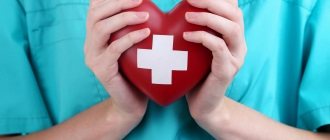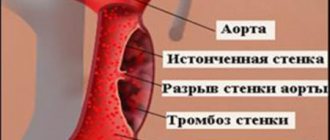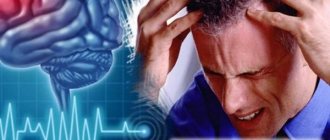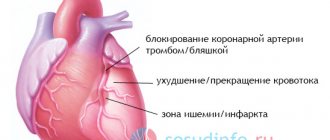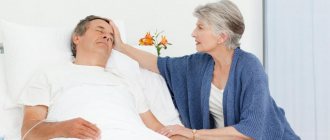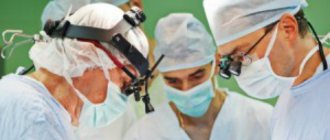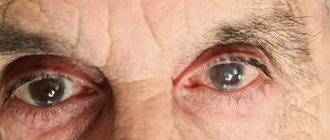Features of the disease, definition
Sudden coronary death occurs due to malfunctions of the electrical cardiac system. These disorders lead to very rapid contractions of the heart, which in turn provoke flutter and fibrillation of the atria and ventricles. As a result of failures, blood stops flowing to vital organs.
Without proper medical care, the death of the patient occurs within a few minutes. Cardiopulmonary resuscitation, which is performed manually or with portable defibrillators, can bring him back to life.
The principle of resuscitation is that by compressing the chest and filling the lungs with air through the mouth, the patient receives oxygen to nourish the brain and restore cardiac activity.
Clinical signs of sudden cardiac death
Lack of consciousness.
Lack of breathing is an obvious sign of circulatory arrest, after which 40% continue to gasp – agonal breathing.
The absence of a pulse in the main vessels is an absolute sign of circulatory arrest, but no time is spent on checking it due to the difficulties of determination.
In the vast majority of cases, the ECG shows ventricular fibrillation.
Asystole develops with late initiation of resuscitation measures or resuscitation without defibrillation.
Electrical activity without a pulse often develops in shock, pulmonary embolism, acute respiratory failure, and others, which are preceded by symptoms of hypovolemia or hypoxia.
At the prehospital stage, ECG monitoring with an electrocardiograph is not used to determine the cause of cardiac arrest, resuscitation is started immediately.
A defibrillator-monitor allows assessment of heart rhythm without compromising tactics, but requires handling skills.
An automatic defibrillator is optimal for outpatient conditions, does not require handling skills, detects ventricular fibrillation, and gives a command to perform defibrillation.
Immediate initiation of resuscitation measures increases the effectiveness of treatment by 2–3 times.
Under certain circumstances (lack of skill, fear of infection), only closed cardiac massage without mechanical ventilation is allowed, but not in a general practice department or hospital.
In case of pulseless ventricular tachycardia or ventricular fibrillation, early defibrillation is the main thing to save life.
The effectiveness of resuscitation increases by 49–75% with defibrillation 3–5 minutes after circulatory arrest; each minute of delay reduces survival by 10–12%.
Classification and forms
A person can die not only from a long illness. A striking example of this is sudden coronary death. This condition results from disturbances in the contractile functions of the left and right ventricles of the heart.
The International Classification of Diseases divides sudden coronary death into two forms:
- Clinical VCS. This form allows the patient to be brought back to life, even if he is unconscious and his breathing cannot be heard.
- Biological VKS. Carrying out cardiopulmonary resuscitation in such a situation will not help save the patient.
This disease has even been assigned a special code – ICD-10.
Based on the speed of onset, this state is divided into instantaneous and rapid. In the first case, death occurs within a few seconds. If death occurs within an hour, then we are talking about a rapid form.
Causes of sudden death
Statistics show that the main cause of most deaths is heart disease: ischemic pathology, the onset of ventricular fibrillation. At the same time, when answering what causes instant death, experts often name chronic illnesses that occur in a latent form for a long time, after which they suddenly worsen and lead to the unexpected death of a person. One of these deadly diseases is cancer.
In most cases, oncology develops asymptomatically and makes itself felt when the patient is often considered hopeless. Thus, malignant liver disease is the main cause of unexpected deaths in China. Another insidious disease that can lead to sudden death is AIDS, which claims millions of lives in Africa every year. In addition, it is worth mentioning separately about Mexico. This is the only country in which cirrhosis of the liver is the main cause of high mortality in the population.
In young age
Today, young men and women are exposed to the negative influence of modern lifestyle every day. From TV screens and the covers of fashion magazines, the cult of a slender (often dystrophic) body, accessibility and promiscuity is imposed on young people. Therefore, it is quite understandable that the mortality rate of people just beginning their life journey will increase over time. The main causes of instant death among boys and girls under 25 years of age are considered to be:
- alcohol;
- smoking;
- promiscuity;
- drug addiction;
- poor nutrition;
- psychological sensitivity;
- hereditary diseases;
- severe congenital pathologies.
In a dream
Unexpected death in this condition occurs due to the loss of special cells responsible for the contractility of the lungs. Thus, scientists from the USA were able to prove that people die in their sleep in most cases due to central sleep apnea. In this case, a person may even wake up, but still leave this mortal world due to oxygen starvation caused by a stroke or cardiac arrest. As a rule, elderly people are susceptible to this syndrome. There are no specific treatments for central sleep apnea.
Sudden infant death
This syndrome was first described in the early 60s of the last century, although cases of instant death of infants were recorded earlier, but they were not subjected to such a thorough analysis. Young children have very high adaptive abilities and incredible resistance to a variety of negative factors, which is why the death of an infant is considered an exceptional situation. However, there are a number of external and internal reasons that can lead to sudden child death:
- prolongation of the QT interval;
- apnea (the phenomenon of periodic breathing);
- deficiency of serotonin receptors;
- overheat.
Causes
Having understood what acute coronary death is, an important issue for patients suffering from cardiovascular diseases remains to determine the reasons why this happens. The main factors provoking the occurrence of VCS include:
- aortocoronary heart attack, resulting in damage to the middle muscular layer of the heart - the myocardium;
- the presence of coronary heart disease (CHD), which increases the risk of sudden cardiac death by 80%;
- insufficient levels of potassium and magnesium in the body;
- primary and secondary cases of cardiomyopathy, contributing to the deterioration of the pumping function of the heart;
- unhealthy lifestyle, alcoholism, excess body weight, diabetes;
- congenital heart defects, cases of instant cardiac death in relatives;
- coronary vascular atherosclerosis.
Knowing the causes of acute coronary death, it is necessary to do everything possible to prevent the development of VCS.
Main symptoms
Often sudden death in acute coronary insufficiency does not come so suddenly. It is usually preceded by some symptoms.
According to relatives, many patients before their death noted a deterioration in their general health, weakness, poor sleep, and breathing problems. Some experienced severe attacks of ischemic pain. This pain appears sharply, it seems to compress the chest, radiating to the lower jaw, left arm and shoulder blade. But ischemic pain is a rare symptom before death from acute coronary insufficiency.
Many patients suffered from high blood pressure or mild coronary heart disease.
In 60% of cases, death due to heart disease occurs at home. It has nothing to do with emotional shock or physical stress. There have been cases of sudden death during sleep from acute coronary insufficiency.
Symptoms of sudden coronary death
Pathanatomy identifies several characteristic symptoms for this condition, including:
- strong heartbeat;
- increasing shortness of breath;
- attacks of pain near the heart;
- noticeable decrease in performance;
- fast fatiguability;
- frequent attacks of arrhythmia;
- sudden dizziness;
- loss of consciousness.
Some of these signs are especially common in people who have had a heart attack. They should definitely be regarded as harbingers of an approaching threat. They indicate an exacerbation of pathologies of the cardiovascular system. Therefore, at the first symptoms of impending danger, you should seek medical help as quickly as possible. Otherwise, all this could end in disaster.
Diagnostics
An important diagnostic measure for identifying problems in the heart is an ECG. If VCS is suspected, the patient will show erratic wave-like contractions during fibrillation on the electrocardiogram. In this case, the heart rate can reach 200 beats per minute. When a straight line appears instead of waves, this indicates cardiac arrest.
If resuscitation efforts are successful, then in the hospital the patient will have to undergo multiple laboratory tests. In addition to donating blood and urine, a toxicology test may be performed regarding drugs that can cause arrhythmia.
Coronary angiography, daily ECG monitoring, cardiac ultrasound, electrophysiological examination and stress testing are mandatory.
Differential diagnosis
During the diagnostic process at the stage of emergency care, it is necessary to take into account that clinical death can be caused not only by ventricular fibrillation, but also by other causes. With immediate recording of an electrocardiogram, it is easy to determine the cause of this condition:
- with ventricular fibrillation, a characteristic curve is recorded;
- asystole is manifested as an isoline on the ECG;
- with pulmonary embolism or cardiac tamponade, there is no blood circulation, but the electrical activity of the heart persists for some time, gradually disappearing.
However, it is not always possible to quickly record an electrocardiogram. In cases where it is not present, one has to focus on the initial signs of clinical death and the body’s reaction to resuscitation measures.
- With ventricular fibrillation, effective contractions of the heart do not occur and death occurs instantly. Breathing disappears 1-2 minutes after blood circulation stops. Such patients have a positive reaction to resuscitation measures.
- With severe conduction disturbances and advanced blockades, circulatory disorders develop gradually. First, consciousness becomes darkened, then motor agitation and convulsions appear. In some cases, with timely assistance, it is possible to achieve an effect.
- With massive thromboembolism, death occurs suddenly. The primary cause is respiratory arrest, and cyanosis of the upper body may be observed. The response to emergency care is unclear.
- Cardiac tamponade is characterized by severe pain, after which a sudden stop of cardiac activity occurs, breathing stops within 1-3 minutes, and there are no convulsions. Resuscitation measures do not give the desired results.
Treatment
Only emergency assistance in case of sudden coronary death will help bring a person back to life. The patient should be positioned on a solid base and the carotid artery should be examined. If breathing stops, you should alternate cardiac massage with artificial ventilation. Resuscitation involves delivering a single blow to the middle of the sternum.
The emergency algorithm is as follows:
- indirect cardiac massage (up to 90 compressions in 60 seconds);
- artificial respiration (30 seconds);
- defibrillation, requiring the use of special equipment;
- intravenous administration of adrenaline and lidocaine through an inserted catheter.
If there is no proper result, the patient is administered Ornid, Novocainamide, and Magnesium sulfate. In case of asystole, emergency administration of the drug “Atropine” is required.
If a person managed to avoid sudden death, further therapy involves preventing relapse.
For heart failure
In 85% of cases, immediate death is recorded in individuals with structural abnormalities of the organ that pumps blood into the vessels. In this case, sudden cardiac death looks like a lightning-fast clinical variant of coronary disease. Medical practice shows that in a quarter of people who die instantly, bradycardia and episodes of asystole are observed before the onset of primary symptoms. Death from cardiac arrest occurs due to the launch of the following pathogenetic mechanisms:
- Reducing left ventricular fractional ejection by 25-30%. This syndrome greatly increases the risk of sudden coronary death.
- Ectopic focus of automatism in the ventricle (more than 10 ventricular extrasystoles per hour or unstable ventricular tachycardia), arising as a consequence of ventricular arrhythmias. The latter mostly develop against the background of acute transient myocardial ischemia. An ectopic focus of automatism is usually classified as a risk factor for sudden arrhythmic death.
- The process of spasm of the blood vessels of the heart, which leads to ischemia and contributes to the deterioration of the restoration of blood flow to damaged areas.
It is worth noting that tachyarrhythmia is a particularly significant electrophysiological mechanism resulting in sudden coronary death in a person with heart failure. At the same time, timely treatment of this condition using a defibrillator with a modified pulse configuration significantly reduces the number of deaths among patients who have suffered sudden cardiac arrest.
From a heart attack
Blood enters the heart through the coronary arteries. If their lumen closes, the formation of primary foci of necrosis and ischemia in the heart occurs. Acute manifestation of cardiac pathology begins with damage to the vascular wall with further thrombosis and spasm of the arteries. As a result, the load on the heart increases, the myocardium begins to experience oxygen starvation, which affects its electrical activity.
As a result of a sudden coronary spasm, ventricular fibrillation occurs, a few seconds after which a complete cessation of blood circulation to the brain occurs. At the next stage, the patient experiences respiratory arrest, atony, and absence of corneal and pupillary reflexes. After 4 minutes from the onset of ventricular fibrillation and complete cessation of blood circulation in the body, irreversible changes occur in the brain cells. In general, death from a heart attack can occur in 3-5 minutes.
From a blood clot
In the venous bed, these pathological formations arise due to the uncoordinated work of the coagulation and anticoagulation systems. Thus, the onset of the appearance of a clot is caused by damage to the vascular wall and its inflammation against the background of thrombophlebitis. Perceiving the appropriate chemical signal, the coagulation system comes into action. As a result, fibrin threads form near the pathological area, in which blood cells become entangled, creating all the conditions for the blood clot to break off.
In arteries, the formation of clots occurs due to narrowing of the vascular lumen. Thus, cholesterol plaques block the path of free blood flow, resulting in the formation of a lump of platelets and fibrin threads. It is important to note that in medicine a distinction is made between floating and mural thrombi. Compared to the first type, the latter has a slight chance of breaking off and causing a blockage (embolism) of the vessel. In most cases, the causes of sudden cardiac arrest from a blood clot are due to the movement of a floating thrombus.
One of the serious consequences of the separation of such a clot is blockage of the pulmonary artery, which is expressed in a strong cough and bluish skin. Often there is respiratory failure followed by cessation of cardiac activity. An equally serious consequence of the detachment of a blood clot is a violation of cerebral circulation due to embolism of the main vessels of the head.
Disease prevention
Informing patients at risk, as well as their family members, about the possible consequences of this dangerous condition can be considered as preventive methods for preventing VCS.
The principles of prevention are as follows:
- careful attention to your health;
- timely taking of prescribed medications;
- compliance with medical recommendations.
Pharmacological support helps to achieve a good effect. As a rule, patients with heart disease are prescribed antioxidants and beta-blockers. Among the drugs that can be used are “Aspirin”, “Curantil”, “Preductal”.
At the same time, it is very important to give up bad habits and, if possible, avoid stress and excessive physical activity. If there are cardiac pathologies, the patient should not stay for a long time in rooms where it is too stuffy.
Other causes of sudden death
The most common cause of sudden death is acute coronary insufficiency, which occurs due to coronary heart disease and various types of arrhythmias.
But sometimes patients die suddenly, never having had any rhythm disturbances or any other heart disease. And at autopsy it is not possible to find damage to the heart muscle. In such cases, the cause may be one of the following diseases:
- hypertrophic or dilated cardiomyopathy - heart pathology with thickening of the myocardium or enlargement of organ cavities;
- dissecting aortic aneurysm - sac-like bulging of the vessel wall and its further rupture;
- pulmonary embolism - blockage of pulmonary vessels with blood clots;
- shock – a sharp decrease in blood pressure, accompanied by a deterioration in the supply of oxygen to tissues;
- food entering the respiratory tract;
- acute circulatory disorders in the vessels of the brain.
Complications
Even successfully performed resuscitation is not a guarantee that a person will not experience complications after VCS. Most often they appear in the form of:
- circulatory disorders;
- heart failure;
- nervous system disorders;
- chest injuries.
It is almost impossible to predict the severity of complications. Their occurrence largely depends on the quality of resuscitation performed and the individual characteristics of the human body.
Diagnostic methods
If a person who was at risk of death from acute coronary insufficiency has been resuscitated, they undergo a series of examinations. This is necessary to prescribe appropriate treatment that will eliminate the threat of relapse.
For this, the following diagnostic methods are used:
- electrocardiography (ECG) – it is used to record the contractility of the heart muscle and the conduction of impulses in it;
- phonocardiography – it characterizes the functioning of the heart valves;
- echocardiography - ultrasound examination of the heart;
- ECG with stress tests - to detect angina pectoris and decide on the need for surgical intervention;
- Holter monitoring - ECG, which is recorded 24 hours a day;
- electrophysiological study.
Forecast
Coronary death is a reversible condition, but subject to emergency medical care. Many patients suffer from central nervous system disorders after cardiac arrest. Some patients remain in a coma. In such situations, the prognosis depends on the following factors:
- quality of resuscitation measures;
- the patient's health status before the cessation of cardiac activity;
- the period of time from the onset of cardiac arrest to the start of resuscitation.
To avoid such problems, patients should lead a healthy lifestyle, attend exercise therapy classes and adhere to the doctor’s instructions. It is very important to eat right and follow a work and rest schedule. Such simple recommendations will help you feel good and eliminate the risks of acute coronary death.
Medical care for sudden death
Typically, most cases of unexpected cardiac arrest occur outside the hospital. For this reason, it is extremely important to master the technique of providing emergency care in case of sudden clinical death. This is especially true for subjects of society who, due to their job responsibilities, come into contact with a large number of people. Remember, competent resuscitation actions immediately in the first minutes after the onset of symptoms of cardiac arrest will help gain time until medical workers arrive.
Urgent Care
The main problem that arises in unconscious persons is obstruction of the airways by the root of the tongue and the epiglottis due to muscle atony. It must be said that this condition develops in any position of the body, and when the head is tilted forward, it develops in 100% of cases. Therefore, the first thing that needs to be done is to ensure proper airway patency. For this purpose, you need to use P. Safar’s triple technique, consisting of the following sequential actions:
- Throwing back the head;
- Moving the lower jaw forward;
- Opening the mouth.
Once airway patency is ensured, you should proceed to artificial pulmonary ventilation (ALV). When providing first aid, this activity is carried out using the mouth-to-mouth method. So, one hand is placed on the victim’s forehead, while the other pinches his nose. Then the resuscitator fixes his own lips around the mouth of the person being revived and blows air, while controlling the excursion of the patient's chest. When it is visible, you need to release the victim’s mouth, giving him a chance to exhale passively.
At the next stage, artificial maintenance of blood circulation is carried out, to ensure which an algorithm for performing indirect cardiac massage or chest compression is used. For this purpose, you need to correctly lay the person being resuscitated on a flat surface. Next, you should determine the compression points: by palpating the xiphoid process and moving away from it 2 transverse fingers upward.
The hand must be placed on the border of the middle and lower part of the sternum so that the fingers are parallel to the ribs. Pushes are performed with the limbs straightened at the elbows. Chest compression is performed at a frequency of 100 compressions per minute with a break for artificial ventilation. The depth of the shocks is about 4-5 cm. Measures to restore cardiac activity should be stopped if:
- A pulse appeared in the main arteries.
- The actions taken do not have the desired effect within 30 minutes. The exception is the following conditions that require prolongation of resuscitation:
- hypothermia;
- drowning;
- drug overdose;
- electrical injury.
Resuscitation measures
Today, the concept of CPR is based on strict rules that ensure complete safety of the activities carried out for human life. In addition, an algorithm for the resuscitator’s actions in case of sudden cardiac arrest or sudden loss of respiratory function in the injured person is presented and scientifically substantiated. In the development of these conditions, time plays a major role: only a few minutes separate a person from death. The algorithm for performing cardiopulmonary resuscitation involves performing the following actions:
- Determining the condition of the victim, on the basis of which the range of measures necessary for revival is selected;
- Early initiation of CPR, which involves performing two manipulations: chest compressions and artificial ventilation.
- If the second stage is ineffective, they proceed to defibrillation. The procedure involves applying an electrical impulse to the heart muscle. In this case, direct current discharges should be applied only if the electrodes are correctly positioned and have good contact with the victim’s skin.
- At this stage, as a rule, the victim is provided with specialized medical care, including the following early treatment measures:
- artificial ventilation with tracheal intubation;
- drug support, involving the use of:
- catecholamines (adrenaline, atropine);
- antidiuretic hormones (Vasopressin);
- antiarrhythmic drugs (Cordarone, Lidocaine);
- fibrinolytic agents (Streptokinase).
- intravenous drip administration of electrolyte or buffer solutions (for example, sodium bicarbonate is administered for acidosis)
